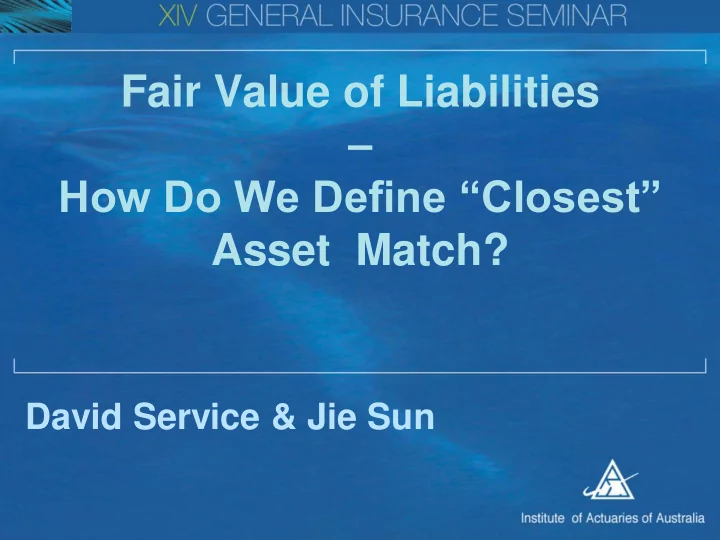

Fair Value of Liabilities – How Do We Define “Closest” Asset Match? David Service & Jie Sun
Fair Value • Assets are OK – Normally a market • No market for long tail claims liabilities • Approach requires the “closest match” asset portfolio • Use the discount rate implied by those assets to discount liability cashflows
Ultimate Surplus • Project asset and liability cashflows • When all liabilities extinguished what assets remain are the “ultimate surplus” • “Closest match” defined by reference to this ultimate surplus • Most important risk for insurance company is insolvency • Insolvency = negative ultimate surplus
“Closest Match” • With stochastic cashflows the probability of insolvency is always non- zero [unless infinite initial asset amount] • As initial assets probability of insolvency • Two variables – Probability of insolvency – Initial asset amount • Need to fix one of these to produce a unique solution
“Closest Match” – [2] Closest Match is The asset portfolio which, for a given probability of negative ultimate surplus, requires the lowest initial asset amount.
Liabilities • Long tail outstanding claims • Runs off in 10 years • Quarterly time intervals • Experience run-off triangle shown in Appendix A
Liability Model • Stochastic chain ladder (Renshaw & Verrall) • Modelled as a GLM • Log link function • Gamma error distribution • Linear predictor – + i + i
Asset Model • Asset Classes – 90 day bank bills – 10 year governemnt bonds – Australian equities : All Ordinaries Index • Jon Carter’s model – An expanded Wilkie type cascade structure – Fitted to the Australian markets
Asset Portfolios • 100% cash • 100% bonds • 100% equities • Balanced – 30% cash, 30% bonds, 40% equities
Probabilities of Insolvency Initial All Cash All Bond All Equity Balanced Asset Amount 50000 100.00% 100.00% 97.33% 100.00% 60000 99.99% 100.00% 87.57% 99.96% 70000 96.90% 100.00% 67.78% 95.68% 80000 50.08% 99.37% 46.15% 62.09% 90000 4.27% 78.44% 27.98% 20.16% 100000 0.06% 36.22% 16.99% 3.42% 110000 0.02% 12.06% 9.48% 0.33% 120000 0.03% 3.42% 4.88% 0.02% 130000 0.01% 0.83% 3.02% 0.05% 140000 0.01% 0.10% 1.50% 0.01% 150000 0.04% 0.03% 0.93% 0.03% 160000 0.05% 0.02% 0.43% 0.04% 170000 0.05% 0.04% 0.21% 0.03% 180000 0.01% 0.00% 0.16% 0.01%
Probabilities of Insolvency 120.00% 100.00% 80.00% Cash Bonds 60.00% Equities Balanced 40.00% 20.00% 0.00% 50 60 70 80 90 100 110 120 130 140 150 160 170 180 $'000
Further Research • Different asset models • Different liability portfolios • Complete interactions between asset and liability models
Recommend
More recommend